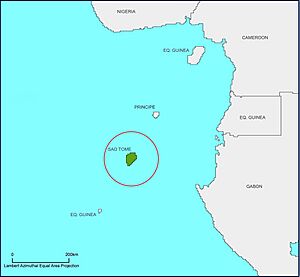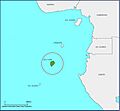São Tomé grosbeak facts for kids
Quick facts for kids São Tomé grosbeak |
|
|---|---|
| Conservation status | |
| Scientific classification | |
| Genus: |
Crithagra
|
| Species: |
concolor
|
 |
|
| range | |
| Synonyms | |
|
|
The São Tomé grosbeak (Crithagra concolor) is a special bird found only on São Tomé. It is the biggest type of canary in the Crithagra family. This bird is 50% heavier than the next biggest canary. It also has a very large beak for a bird of its kind.
For a long time, people thought this bird might be gone forever. Only three old bird samples from the 1800s were known. But in 1991, scientists found it again! Today, there are fewer than 250 of these birds left. Because of this, it is listed as critically endangered by the IUCN. This means it is at a very high risk of disappearing. The biggest danger to the São Tomé grosbeak is losing its home, which is called habitat destruction.
Scientists used to call this bird Neospiza, which means "new finch". But after studying its DNA, they learned it belongs in the Crithagra group. This helps them understand how different birds are related.
Contents
Where Does the São Tomé Grosbeak Live?
At first, people thought the São Tomé grosbeak only lived in forests near the coast. But recently, they have seen these birds in other forests too. These new places are higher up on the island. This bird usually stays high in the trees. It is also very quiet, which makes it hard to spot.
It is easier to see the grosbeak during the short dry season. This is when many birds are having their babies. The São Tomé grosbeak often moves around alone or in pairs. It sometimes flies down to the forest floor to eat seeds. It uses its strong beak to crack them open. Knowing where and how this bird lives is very important. This information helps protect it on São Tomé.
Why Is the São Tomé Grosbeak in Danger?
How Forests Have Changed Over Time
In the past, many lowland forests were cut down. People used these areas to grow cocoa plants. When these farms were left empty, new forests grew back. But these new forests are not as good for the São Tomé grosbeak. Also, new farms for oil palm trees have taken away even more of their home.
Animals That Might Be a Threat
Some animals that are not native to São Tomé have been brought to the island. These include the Black Rat, Mona Monkey, African Civet, and wild cats. Scientists are worried these animals might hunt the São Tomé grosbeak. More research is needed to see how much these animals affect the bird's population.
Images for kids



